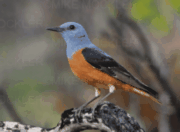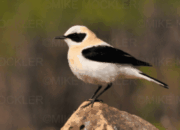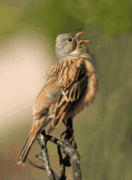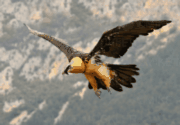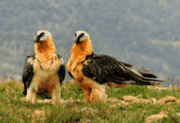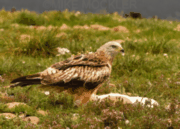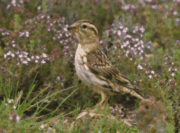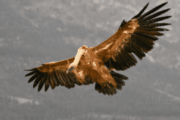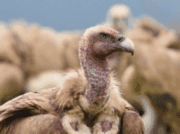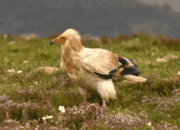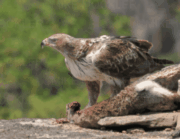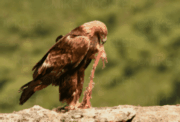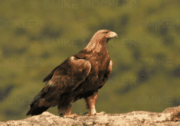|
Mike Mockler Spain - Bird photography |
SPRINGTIME BIRD PHOTOGRAPHY Once again, I was drawn back to Spain for some hide photography. As usual, the first "base camp" was in the foothills of the Pyrenees in Catalunya where birds of prey and vultures are especially abundant. In fact, the first target species was a passerine that I have managed to photograph before in Spain and Romania, albeit never to my total satisfaction. The male Rock Thrush (or, to give it its full name, Rufous-tailed Rock Thrush) is a splendid bird, arguably the loveliest of all the thrush family. Its preferred habitat is wild and rocky slopes in remote, rugged terrain so access to these birds is never easy. There were photo-opportunities with other species at the same location. These included a gorgeous singing male Black-eared Wheatear and a male Ortolan Bunting, also singing. Both are extremely attractive species. Elsewhere in the foothills of the Pyrenees, gigantic, towering cliffs provide nest-sites Griffon Vultures, Egyptian Vultures and the magnificent Lammergeier, or Bearded Vulture. This is surely the most spectacular of all the vultures. However, Griffon Vultures are the most numerous and relatively easy to photograph, whereas the much smaller Egyptian Vulture is far less common. Its scarcity, along with its more rapid and agile flight makes it more of a challenge for photographers. As always, the rare Lammergeier was the great prize so it was really exciting to have two mature adult birds standing side by side at close range. Lammergeiers eat a lot of bones: the juices in their digestive system can break down surprisingly large bones, giving them access to the precious marrow. It is extraordinary to watch them take bones over a foot long into their mouths and swallow them like a sword-swallower. At close range, Lammergeiers have a tremendous presence. Not only are they among the largest vultures, they are also very beautiful with honey-coloured bodies, chocolate-brown wings and creamy white eyes with striking red eye-rings. The black "beard" provides a startling final flourish. Also present were several Ravens, a fine-looking Red Kite and a male Rock Sparrow that hopped around in search of small insects and seeds unconcerned about the Griffons and Lammergeiers towering over him. Rock Sparrows are not uncommon birds but can be difficult to see. Modestly-plumaged, they are nevertheless neat and dapper little birds. Mature males have a small yellow patch on their throats, often very hard to see. This particular individual was well endowed in this respect. A long drive west from the vulture site in Catalunya lies the wildlife-rich Arribes del Duero Natural Park right on the Portuguese border. The plan here was to try to photograph some of the birds of prey that frequent this wild area, though there were many other species to be seen including Black Stork, Linnet, Serin, Sardinian Warbler, Subalpine Warbler and Golden Oriole. Most large birds of prey are very sensitive and shy so a good hide is absolutely essential for successful photography. Golden Eagles and Bonelli's Eagles, both of which thrive in Arribes del Duero, are particularly wary birds. Fortunately, many hours of waiting were eventually rewarded with wonderful opportunities with both species. I had photographed Golden Eagles before but these birds have such charisma I was eager to seize any opportunity to secure more images of this iconic species. However, the scarce Bonelli's Eagle, slightly smaller than "Goldies", was a new photographic subject for me. This superb predator is unusual in that male and female regularly hunt together, working as a formidable team. They are considerably smaller than most other Aquila eagles, such as Golden Eagle, but what they lack in size they more than make up for with their teamwork. On one memorable occasion, my wife, Pat, and I saw a pair of Bonelli's Eagles kill a White Stork in flight. The drama began with the male Bonelli's harrassing a flying White Stork above us. The stork was around twice the size of the eagle so he appeared to be achieving little apart from slowing the stork's progress. Then the female eagle suddenly appeared as if from nowhere, rocketing down in a lethal stoop. She struck the unfortunate stork with such force that she killed it instantly, after which they spiralled down to the ground with the lifeless victim dangling from her talons. The male had apparently been causing a distraction to set the stork up for his female to make the kill; he flew down to perch on the top of a small nearby tree as if to assess the results of his handiwork. It was truly a once-in-a-lifetime sighting that I would not have believed possible had I not witnessed it with my own eyes. Having seen that sequence of events several years earlier, I was now looking at a pair of Bonelli's Eagles in my camera viewfinder at point-blank range. A thrilling experience! Muchas gracias, Carlos and Carles!
|
|
